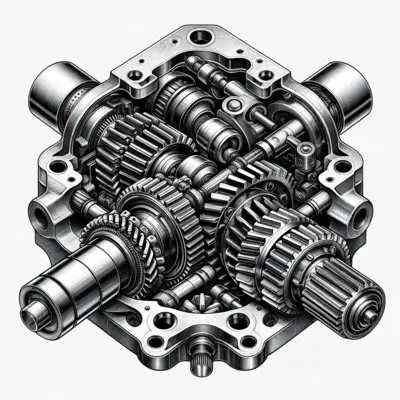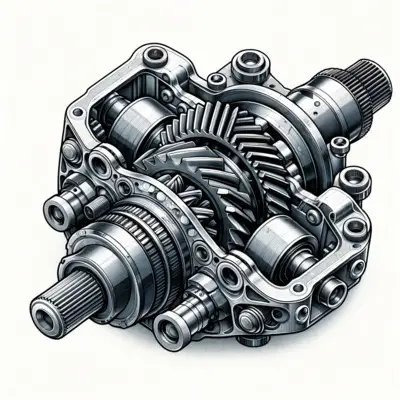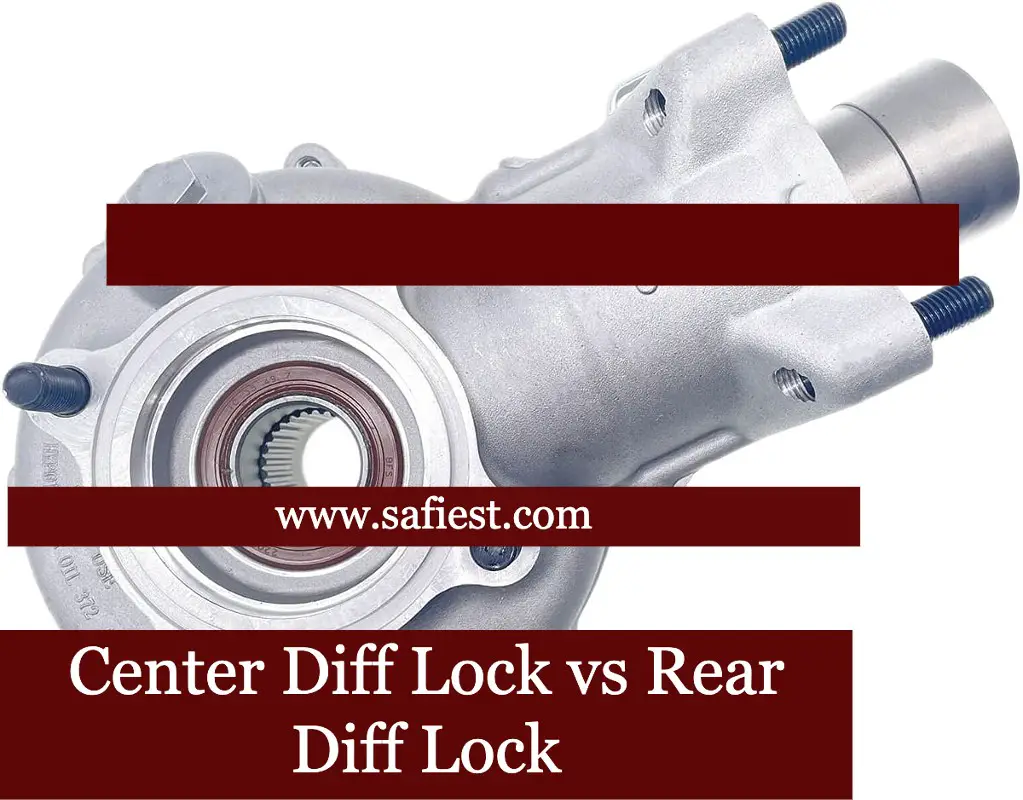When going off-road, differential locks are one of the most important tools you can have. In this article, we will discuss all the major differences between the center diff lock and the rear diff lock.
When going over rough terrain, a center diff lock locks the front and back axles together so that both wheels on each axle can turn at the same speed. This keeps the wheels from spinning and helps spread the torque properly across all four wheels, which makes the car more stable.
A rear diff lock is a little different because it only locks the rear axle. This lets power move from one side of the vehicle to the other more effectively. It also stops the wheels from spinning and makes them stick better when it’s wet or slippery. Also, the design of rear diff locks tends to be simpler than that of center diff locks. This makes them easier and cheaper to install and maintain.
Both types of diff locks are very useful, but they can be used and help in different ways. Center diff locks work best when both axles need to work together off-road, while rear diff locks work best when only the back wheels need to work together, such as when mud-bogging or climbing over rocks. In the end, it’s up to the driver to decide which type of shift lock will work best for them.
No matter which type of diff lock you pick, it can be a very useful tool for going off-road. We will discuss all the details below so you can ultimately decide which lock to pick for your car. So let’s dive in:
Center Diff Lock vs Rear Diff Lock In a table
To compare Center Differential Lock and Rear Differential Lock, we can create a table highlighting their key features and differences:
| Feature/Aspect | Center Differential Lock | Rear Differential Lock |
|---|---|---|
| Primary Function | Balances torque between the front and rear axles | Locks the rear axle to ensure both wheels spin at the same speed |
| Usage Scenario | Ideal for slippery or uneven terrain where traction varies between the front and rear of the vehicle | Used in extreme off-road conditions where one rear wheel loses traction |
| Effect on Handling | Maintains balanced handling and control; prevents excessive wear on drivetrain components | Can improve traction in difficult conditions but may reduce handling on regular surfaces |
| Vehicle Control | Provides better control and stability on mixed-traction surfaces | Offers increased traction at the cost of some maneuverability |
| Impact on Tire Wear | Can reduce uneven tire wear due to balanced distribution of torque | May cause increased tire wear if used on hard surfaces due to the forced synchronization of wheel rotation |
| Typical Vehicle Type | Common in all-wheel-drive vehicles, especially those designed for varied terrain | Often found in heavy-duty off-road and 4×4 vehicles specialized for rough terrain |
What is a Center Diff Lock?

The main role of the central diff lock is to divide drive power. If you are familiar with auto mechanics, you will realize that the drive of the vehicle is not only about the engine’s power but also how it is distributed to the wheels.
Some all-wheel-drive (AWD) cars have a center differential lock. As the name suggests, it is available in all-wheel drive and constant 4WD versions, such as the popular LandCruiser 200 Series wagon.
It enables the driver to physically lock or unlock the center differential, which connects the front and rear axles. When engaged, the locked center differential distributes power equally to all four wheels regardless of road or terrain conditions.
It also prevents excessive wheel spin, which can occur when power is applied too rapidly with an unlocked center differential. When traversing difficult terrain or off-road trails, a locked center differential allows for more accurate control.
Center diff lock can greatly enhance vehicle capabilities and safety when driving in extreme or low traction environments.
What exactly is a Rear Diff Lock?

A rear diff lock is an additional locking mechanism for a vehicle’s back differential. In contrast to the center differential lock, the rear and front-end diff locks are situated at the front or back of the wheel drive. That is, inside the differential, between the front and back two wheels.
When engaged, it enables both rear wheels to rotate at the same speed regardless of which side of the axle has traction. This is particularly helpful when driving in extreme off-road conditions like mud, sand, or snow, where one wheel may lose traction but the other has enough grip to pull the vehicle through.
A rear diff lock can also reduce drivetrain component wear and strain by reducing power transfer between the left and right sides of the axle via differential action. The torque that can be transferred when a rear diff lock is activated is determined by the design of your vehicle’s differential system. A rear diff lock on most vehicles will provide enough torque to guarantee the vehicle makes it through the difficult terrain.
An onboard switch is typically used to engage and disengage a rear diff lock, but some cars may require manual intervention. When using your rear diff lock, keep in mind that as long as both wheels are rotating at the same speed, you should be fine in any circumstance – even if one wheel has traction while the other does not.
You can greatly improve your chances of navigating difficult off-road conditions by properly using a rear diff lock.
What Are the Differences Between Center Diff Locks and Rear Diff Locks?
Center diff locks and rear diff locks are two different types of locking differentials found in four-wheel drive vehicles. Here are the main differences between the two:
Position
Center differential locks almost always require a transfer case, which is situated between the transmission and the front and rear axles of the vehicle. Vehicles that have independent suspension systems for both the front and the back axles typically have rear differential locks installed.
Operation
When a center differential lock is engaged, the front and back driveshafts are connected to one another. This ensures that torque is distributed in an even manner to all four wheels. Because of this, it is possible for all four wheels to move at the same speed regardless of the terrain or any other contributing variables.
When a rear differential lock is activated, however, it only has an effect on a single axle. This axle is typically either on the right or left side of the vehicle, depending on how it is configured. After that, it will only distribute power to two of your four wheels, specifically whichever drive wheels are located on the axle that it is impacting.
Total torque distribution
A center differential lock enables a fixed torque distribution between the front and rear axles, generally in a ratio of 50:50. This maintains vehicle handling. This ensures that the front and rear wheels receive the same torque, which improves the vehicle’s traction and stability in difficult driving conditions like off-roading.
On the other hand, a rear diff lock has no effect on the front wheels and only modifies the way torque is distributed between the left and right back wheels. A rear differential lock equalizes torque to the vehicle’s rear wheels. This serves to prevent one of the wheels from spinning while the other remains still.
Vehicle categories that are appropriate for use
Vehicles that are designed to provide power to all four wheels at all times are known as all-wheel-drive (AWD) vehicles. Center diff locks are generally found in these types of vehicles. It is essential for all-wheel drive vehicles to have a central differential lock because it improves the vehicle’s traction and stability in hazardous or off-road environments.
On the other hand, rear differential locks are more typically found in four-wheel drive (4WD) vehicles, which are intended to send power to all four wheels only when it is absolutely essential to do so.
When traveling over rocks, through deep mud or snow, or in other extreme off-road conditions, drivers of four-wheel-drive vehicles often employ the use of rear differential locks to improve their vehicle’s traction and stability.
Which diff lock is better for off-road and why?
If you want a two-wheel-drive car that can handle rough off-road conditions without much trouble, you should look for one with a rear differential. This type of differential can share power between two wheels on the same axle. This makes sure that all wheels on that axle turn at the same speed.
This is very important for the wheels to turn well. Without a different lock, it’s normal for a car to get stuck in the mud with only one wheel moving.
See also:
